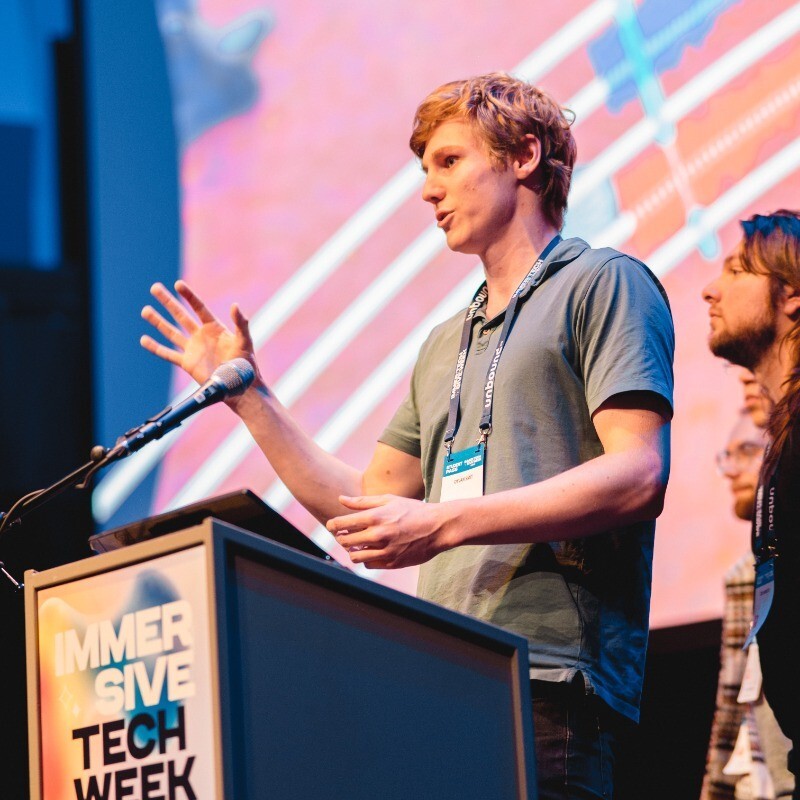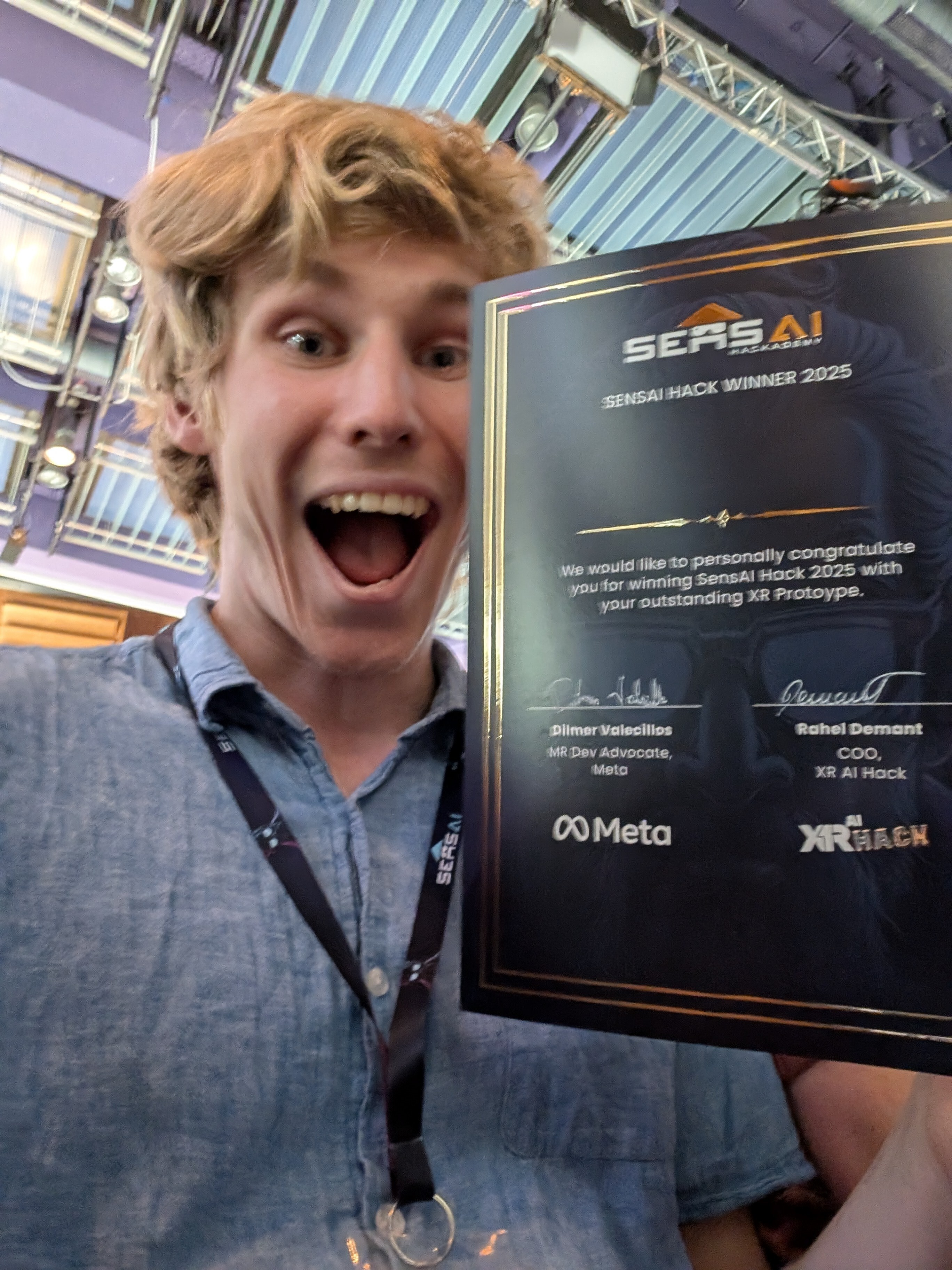
Dylan Smit was at Gamescom: 'My dream within the IX industry is closer collaboration between developers, innovators and companies'
Gamescom is the largest gaming event in the world and took place last week as always in Cologne. What are the latest developments in the IX field in the industry, which is three times larger than the film and music industries combined?
Dylan Smit, developer and founder of immersive studio Dunk Technologies from Utrecht, reports.
Who are you, what do you do? How would you specifically define your expertise in the field of IX/XR?
‘I am Dylan Smit and with my immersive studio Dunk Technologies I create interactive projects that make an impact on users. This can be by teaching them things with IX or by inspiring them with what is now possible with current technology. I also share my knowledge through talks, workshops, and YouTube content, so IX becomes increasingly accessible as the industry and technology further develop.
I myself started in the game development corner. During my studies at HKU, I began to specialize in XR Development & Design, to work on new interactions that provide real solutions. My expertise lies in the field of interaction and Unity (Unity is the largest ‘development platform used by developers to create games, mobile apps, and other types of immersive experiences,’ ed.). I work on both entire Unity productions and small (often graphical) effects to improve and maximally enhance immersion and interaction.’
“What I noticed is that among the entertainment games there were also many applied games.”
Why 'immersive', what is your connection with new content/technology?
'Immersion and innovation have always been important pillars for me. As a teenager, I was already heavily involved with tech, and since 2016, I have been delving into VR and its possibilities. This had a significant impact on me, and since then, I've had a natural urge to share this with others. Professionally, I've also always been interested in the latest developments in games, development, and real-time rendering. This keeps me updated on the latest software, allowing me to continue working on innovative solutions.'
Why did you go to Gamescom? What did you want to bring, what did you hope to gain?
'I went to Cologne for two events. First, I participated in the side track XRAI Hackathon, where I created a 3D modeling tool in Mixed Reality for practical 3D prints. I am proud to say that our team won first place with PrintMR! In short: with Mixed Reality, users can model their 3D designs one-to-one on the real world and send them directly to a 3D printer. We even tested the project during the hackathon! Following that was the Gamescom hackathon itself.'
Additionally, my goal was to expand my network on-site and see what Gamescom has to offer, as this was my first time. For instance, I spoke with people from Meta – it was very valuable to exchange knowledge with their team – and I certainly enjoyed the entertainment side of the event.'
“I was able to try out Deadpool VR from Meta, a great example of a major IP in the IX entertainment industry. This game pushes the Meta Quest 3 headset to its limit with the amount of content and beautiful graphics.”
What remarkable things have you specifically seen or experienced there?
‘What struck me is that among the entertainment games, there were also plenty of applied games. Like a tunnel vision simulation in GazeQuest. Through small mini-games, the visual impairment retinitis pigmentosa (also known as tunnel vision) becomes increasingly clear to players. For example, you had to follow certain content with your eyes. First without impairment, and then with tunnel vision. This way, everyone with good eyesight can experience how people with this visual impairment live. I found the mix of both applied and entertainment games good to see, and it shows that the games industry is maturing.
In addition, I mainly watched the trailers of all the experiences that were there (and did not do whole experiences), so I could see more of Gamescom. Even at that pace, I feel like I missed entire halls of new games!
However, I was able to try out Deadpool VR from Meta, a great example of a major IP in the IX entertainment industry. This game pushes the Meta Quest 3 headset to its limit with the amount of content and beautiful graphics. The game is full of well-developed interactions, making it feel intuitive and easy to pick up. Additionally, the storyline throughout the demo is playful, with many funny moments, especially for a Deadpool fan!
Impressive to see how the team developed this game and what techniques were used. Projects like this demonstrate that the IX industry has moved beyond the ‘tech demo’ phase. I look forward to seeing talks about this game at upcoming IX fairs.
Furthermore, I was not able to experience much completely new hardware during Gamescom. Unfortunately, the new prototypes from Meta were reserved for Siggraph (the computer graphics fair that took place earlier this month in Colorado, ed.). But they are definitely still on my list of hardware I want to try out.
And finally, the people make the event. The most valuable experience was talking to people at the XR get-together and happy hour of the Dutch pavilion; connection is the key to advancing as an industry.’
What new (strategic) insights have you gained?
‘My most important insight came at the Meta booth. I found out there that the MetaStart program is no longer only for studios with existing public projects but now also for creators who (yet) have no public projects. That's great because the program is a very valuable community for XR developers.
Personally, I also realized that I could be a bit more direct when I need something, call it sales experience. For example, during the XR get-together, I spoke with Alexandra Gerard, co-founder of UnitedXR Europe (Europe’s #1 XR event, taking place December 8-10 in Brussels, ed.), and asked her if there was a possibility to demonstrate PrintMR. Fortunately, she was very positive about it, and we are going to investigate that concretely.’
“My dream within the IX industry is a closer collaboration between developers, innovators, and companies from different sectors.”
According to your senses, what are the most important general developments in the field of IX/XR content (as part of the creative industry) at the moment?
‘A major development is the shift in perception about IX/XR. More and more people see that current technology is already much more advanced and has more potential than they thought. IX is therefore seen less as a gimmick or gadget and more as a serious platform with added value. This applies to both entertainment games and more professional applications.
Or let me put it differently, or sharpen it: for a long time, many people associated XR with Google Cardboard, which thankfully has been negated in terms of 'image' by modern hardware. As people increasingly come into contact with it, both personally and professionally, they see IX more and more as an independent platform with unique, real values.’
Public values play an important role at CIIIC, how do you view that? Extra stimulating or a potential obstacle?
‘Since IX works so closely with the user and a lot of information can be gathered here, public values are super important. I believe that everyone involved in the creation process of IX should be aware of this and know what its impact is. If a project is not 100% in line with values such as privacy, inclusion, and respect, conscious choices must be made about what is or is not possible and what the next steps in the process will be.’

CIIIC hopes above all to play a connecting and stimulating role for the IX industry. What challenges and opportunities do you see from your perspective?
‘Connecting is very important to me, and I try to attend many events within the industry. I personally find that I have used CIIIC's events in this way, to network and make connections with people. I see many opportunities with a focus on individual creators, who often sit at the intersection of art and practical applications. I believe that there are many opportunities for innovation at this intersection, which can be a great starting point for future IX applications.’
What is your ultimate IX dream/mission? How do you view the future of this 'branch of sports,' and what do you specifically hope to contribute to it?
‘My clear dream within the IX industry is closer collaboration between developers, innovators, and companies from different sectors. Large industries such as education, defense, and entertainment operate in parallel, whereas collaborations here can have significant impacts. Game-like interactions can, for example, greatly enhance immersion and the amount of knowledge a person acquires in educational applications.
In addition to being a creator, I hope to seriously contribute to this – to the sharing of knowledge and the creation of more connections between the different worlds in which I work.’
Want to stay informed about the developments within CIIIC? Sign up for the newsletter.